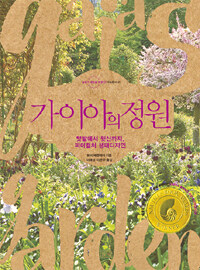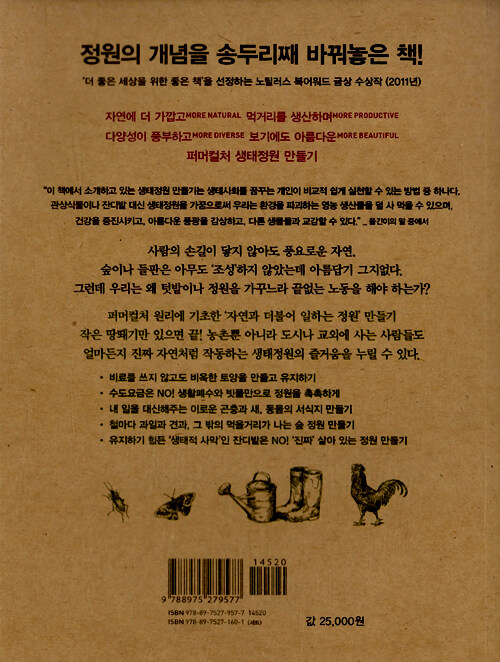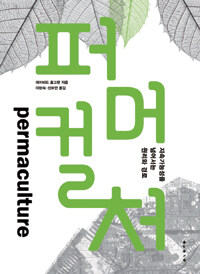알라딘: 가이아의 정원 - 텃밭에서 뒷산까지, 퍼머컬처 생태디자인
이아의 정원 - 텃밭에서 뒷산까지, 퍼머컬처 생태디자인 l 농부가 세상을 바꾼다 귀농총서 45



토비 헤멘웨이 (지은이), 이해성, 이은주 (옮긴이) | 들녘 | 2014-12-18 | 원제 Gaia's Garden (2009년)


정가 25,000원
판매가 22,500원 (10%, 2,500원 할인) | 무이자 할부


 : 농부가 세상을 바꾼다 귀농총서 (총 60권 모두보기)
: 농부가 세상을 바꾼다 귀농총서 (총 60권 모두보기)신간알리미 신청


국내도서 > 과학 > 농업 > 생태농업

농부가 세상을 바꾼다! 귀농총서 45권. 영미권 도서로는 최초로 가정 단위에 퍼머컬처 디자인을 적용해 생태정원을 가꾸는 방법을 안내하는 퍼머컬처 입문서다. 이 책은 독자에게 상상력과 새로운 가능성을 불어넣어 정신적 성장, 의식 있는 삶, 녹색 가치, 긍정적인 사회 변화를 이끄는, ‘더 좋은 세상을 위한 좋은 책’을 선정하는 노틸러스 북어워드(Nautilus Awards)의 금상 수상작(2011년)이다.
퍼머컬처 디자인을 구체적인 실제 사례(부지가 300평쯤 되는 전형적인 미국 교외 주택에 퍼머컬처 디자인 적용하기)를 통해 알아보기에 이보다 더 좋은 책은 없다. 물론 상대적으로 부지가 좁고 주택과 농지가 서로 떨어져 있는 경우가 많은 우리나라에도 이 책의 내용을 적용하는 일이 가능하다. 퍼머컬처는 장소에 따라 적용하는 디자인도 달라지기에, 그대로 옮겨 쓸 수 있는 일반화된 매뉴얼이란 있을 수 없다. 따라서『가이아의 정원』은 생태적으로 농사를 짓거나 정원을 디자인할 때 염두에 두어야 할 중요한 키포인트를 안내해, 각자가 살고 있는 환경에 알맞은 자연농법을 스스로 창안하도록 도와준다.
또한 퍼머컬처 개념을 처음 접하는 독자도 이해할 수 있도록 기본적인 생태학 지식과 생태디자인 원리를 담고 있다. 유용한 식물 리스트에는 북아메리카 원산의 식물이 많지만, 국내 원예시장에서 구할 수 있는 종이 더 많다. 오히려 이 책에 소개한 개념을 바탕으로 우리나라 특유의 작물이나 주변에 자생하고 있는 토착식물을 이용하는 쪽이 창의적이고 바람직한 퍼머컬처다.

1부 생태계로서의 정원
1장 생태정원이란?
■ 퍼머컬처란 무엇인가?
2장 정원사의 생태학
표2-1 미성숙한 생태계와 성숙한 생태계의 차이점
■ 식물군집은 정말로 존재할까?
3장 생태정원 디자인
■ 열쇠구멍 모양 두둑 만들기와 식물 심기
표3-1 무엇을 관찰할 것인가.디자이너가 점검해야 할 항목
표3-2 배나무의 연결 관계
■ 배나무의 연결 관계 몇 가지
표3-3 각 지구의 기능과 내용
■ 생태정원 디자인하기: 요약
2부 생태정원을 이루는 요소
4장 흙 살리기
표4-1 일반적인 피복재와 퇴비 재료의 탄소 대 질소 비율
■ 목질 쓰레기를 이용해서 토양을 조성하는 법
■ 폭탄이 떨어져도 끄떡없는 최강의 시트 피복
■ 시트 피복에 식물 심기
표4-2 피복작물
5장 물을 확보하고, 보존하고, 이용하는 법
표5-1 물을 절약하는 다섯 가지 방법과 그 혜택
■ 스웨일 만드는 법
표5-2 지중해성 기후에 적합한 유용한 식물
■ 집수 시스템 계획하기
■ 생활폐수를 이용할 때 숙지할 점
■ 뒷마당 습지 만들기
표5-3 생활폐수를 정화하는 습지에 적합한 식물
6장 다양한 용도로 쓸 수 있는 식물
표6-1 구체적인 기능 중합의 예
표6-2 역동적 영양소 축적식물
표6-3 질소고정식물
■ 잡초를 비롯한 야생의 먹을거리
표6-4 흔히 찾아볼 수 있는 식용 잡초의 예
표6-5 보모 식물
7장 벌과 새, 그 밖의 유익한 동물 불러오기
■ 익충에는 어떤 종류가 있을까
표7-1 익충을 끌어들이는 식물
표7-2 새에게 유용한 식물
표7-3 가금류의 먹이가 되는 식물
3부 생태정원 만들기
8장 정원을 위한 식물군집 만들기
■ 이안토 에반스의 복합경작
■ 좀 더 발전된 자자르코트의 복합경작
■ 세 자매 길드 만들기
9장 정원 길드 디자인
■ 자연의 식물군집을 길드 디자인의 지침으로 이용하는 법
표9-1 백참나무/개암나무 공동체
표9-2 길드를 이루는 식물의 기능
10장 먹거리숲 가꾸기
■ 숲 정원의 짧은 역사
■ 제롬의 길드와 길드 식물
표10-1 숲 정원에 알맞은 식물들
11장 도시에서 퍼머컬처 정원 가꾸기
12장 폭발하는 생태정원
■ 생태적인 타협 없이는 아무것도 할 수 없다
============
부록
유용한 식물 목록
대교목. 15m 이상 ┃ 소교목·관목층. 1~15m ┃ 초본층 ┃ 유용한 덩굴식물
용어 해설
참고문헌
도움 되는 정보



첫문장
지속가능한 조경을 하려는 운동이 더욱 열기를 띠고 있다.
“생태정원Ecological garden은 환경을 거의 훼손하지 않으며, 한번 만들어놓고 나면 유지하는 데 노력이 많이 들지 않는다. 또한 생산성이 높을 뿐 아니라 미적으로 세련되기까지 하다. 생태정원은 그 모습도, 작동하는 방식도 자연과 꼭 같다. 이 정원은 식물과 ...

“요즘의 친환경·유기 농산물의 유행은 퍼머컬처의 관점을 가지고 보면 반기기만 할 일은 아니다. 무농약 재배가 농약 재배보다야 사람의 건강에는 이롭겠지만, 유기농 농산물조차도 시종을 따져보면 화석연료를 엄청나게 소비하고 있다. 에너지 위기 시대에 지속가능하지 않은 유기농...

=======================

지은이 : 토비 헤멘웨이
저자파일
최고의 작품 투표
신간알리미 신청
 최근작 : <가이아의 정원> … 총 6종 (모두보기)
최근작 : <가이아의 정원> … 총 6종 (모두보기) 소개 :
소개 : 포틀랜드 주립대학교 교육대학원 겸임 교수, 퍼시픽 대학교 주재 연구원, 생체모방학회(Biomimicry Guild) 생물학 컨설턴트로 활동하고 있으며, 1999년부터 2004년까지는 생태디자인과 지속가능한 문화를 다루는 정기간행물인 <퍼머컬처 액티비스트Permaculture Activist>의 편집자를 맡기도 했다. 세계 곳곳을 돌아다니며 퍼머컬처와 생태디자인에 대한 강연과 컨설팅을 한다. 미국 오리건 주 포틀랜드에서 아내와 함께 살면서 도시의 지속가능성을 위한 장소와 자원을 개발하고 있다. patternliteracy.com

옮긴이 : 이해성
저자파일
최고의 작품 투표
신간알리미 신청
 최근작 : … 총 4종 (모두보기)
최근작 : … 총 4종 (모두보기) 소개 : 1986년생. 네 살 때 경남 산청으로 이주하여 지금도 같은 곳에서 살고 있다. 문명 비판적인 입장에서 의식주와 문화생활, 교육의 자급자족을 추구해온 가족의 철학에 따라 초등학교 졸업 후 일체의 정규교육을 받지 않고, 자급농사를 기본으로 다양한 방면에서 활동과 탐색을 해왔다. 생태적이고 지속가능한 삶을 살고 싶은 이들에게 도움이 되는 실용적인 책을 소개하는 일에 관심이 많다. 옮긴 책으로 『매혹의 조련사 뮤즈』, 『아이들은 어떻게 배우는가』(공역)가 있다.
소개 : 1986년생. 네 살 때 경남 산청으로 이주하여 지금도 같은 곳에서 살고 있다. 문명 비판적인 입장에서 의식주와 문화생활, 교육의 자급자족을 추구해온 가족의 철학에 따라 초등학교 졸업 후 일체의 정규교육을 받지 않고, 자급농사를 기본으로 다양한 방면에서 활동과 탐색을 해왔다. 생태적이고 지속가능한 삶을 살고 싶은 이들에게 도움이 되는 실용적인 책을 소개하는 일에 관심이 많다. 옮긴 책으로 『매혹의 조련사 뮤즈』, 『아이들은 어떻게 배우는가』(공역)가 있다. 옮긴이 : 이은주
저자파일
최고의 작품 투표
신간알리미 신청
 최근작 : <유럽 문화와 교육 대국 독일 이야기> … 총 49종 (모두보기)
최근작 : <유럽 문화와 교육 대국 독일 이야기> … 총 49종 (모두보기) 소개 : 서울대학교에서 독어독문학 박사 과정을 수료했습니다.
소개 : 서울대학교에서 독어독문학 박사 과정을 수료했습니다. 같은 학교에서 독일어를 가르쳤으며, 현재는 영어와 독일어 책을 우리말로 옮기는 일을 하고 있습니다.
《독일 이야기》를 집필하였고, 옮긴 책으로는 《우린 널 사랑해》,《성탄절 이야기》, 《아빠는 아프리카로 간 게 아니었다》, 《에밀, 집에 가자》,《루카스의 긴 여행 1, 2》, 《교육오류사전》, 《가이아의 정원(공역)》 들이 있습니다.
---------------

진짜 자연처럼 작동하는 정원은 가능하다!
자연은 사람의 손길이 닿지 않아도 아름답다. 숲이나 들판은 굳이 누가 ‘조성’하지 않았는데 풍요롭기 그지없다. 그런데 우리는 왜 ‘생태 00’를 조성한다는 명목으로 돈을 쓰고, 관리를 하느라 끝없는 노동을 해야 할까? 진짜 자연은 돌보는 사람이 없어도 저절로 작동하고, 야생생물이 제 발로 찾아와 터를 잡는다. 이런 자연의 한 조각을 우리 집 정원에 옮겨놓을 수 있다면?
일종의 생태디자인 방법론인 퍼머컬처Permaculture* 원리를 이용하면 ‘보기 좋고, 생태적이고, 먹거리도 나는 정원’을 만들 수 있다. 생태적인 사막이나 다름없는 잔디밭이나 벌과 나비가 날아들지 않는 관상식물 대신에, 대지의 여신(가이아)이 돌보는 생태정원을 우리 집 마당에 꾸며보자. 이 책에서 이야기하는 생태정원은 보다 생태적인 삶을 살기 위한 수단이며, 생태사회로 나아가기 위한 첫걸음이다.
더 좋은 세상을 위한 좋은 책, 한국형 퍼머컬처를 위한 두 번째 모색
들녘에서는 『농, 살림을 디자인하다: 퍼머컬처로 이루는 농업살림·농장살림·농촌살림』(귀농총서 39)을 통해 한국형 퍼머컬처를 모색한 바 있다. 이번에 출간하는 귀농총서 45번째 책, 『가이아의 정원: 텃밭에서 뒷산까지, 퍼머컬처 생태디자인』은 영미권 도서로는 최초로 가정 단위에 퍼머컬처 디자인을 적용해 생태정원을 가꾸는 방법을 안내하는 퍼머컬처 입문서다.
이 책은 독자에게 상상력과 새로운 가능성을 불어넣어 정신적 성장, 의식 있는 삶, 녹색 가치, 긍정적인 사회 변화를 이끄는, ‘더 좋은 세상을 위한 좋은 책’을 선정하는 노틸러스 북어워드(Nautilus Awards)의 금상 수상작(2011년)이다.
퍼머컬처 디자인을 구체적인 실제 사례(부지가 300평쯤 되는 전형적인 미국 교외 주택에 퍼머컬처 디자인 적용하기)를 통해 알아보기에 이보다 더 좋은 책은 없다. 물론 상대적으로 부지가 좁고 주택과 농지가 서로 떨어져 있는 경우가 많은 우리나라에도 이 책의 내용을 적용하는 일이 가능하다. 퍼머컬처는 장소에 따라 적용하는 디자인도 달라지기에, 그대로 옮겨 쓸 수 있는 일반화된 매뉴얼이란 있을 수 없다. 따라서『가이아의 정원』은 생태적으로 농사를 짓거나 정원을 디자인할 때 염두에 두어야 할 중요한 키포인트를 안내해, 각자가 살고 있는 환경에 알맞은 자연농법을 스스로 창안하도록 도와준다. 또한 퍼머컬처 개념을 처음 접하는 독자도 이해할 수 있도록 기본적인 생태학 지식과 생태디자인 원리를 담고 있다. 유용한 식물 리스트에는 북아메리카 원산의 식물이 많지만, 국내 원예시장에서 구할 수 있는 종이 더 많다. 오히려 이 책에 소개한 개념을 바탕으로 우리나라 특유의 작물이나 주변에 자생하고 있는 토착식물을 이용하는 쪽이 창의적이고 바람직한 퍼머컬처다.
*퍼머컬처permaculture란?
‘영속적인 문화(permanent culture)’와 ‘영속적인 농업(permanent agriculture)’의 축약어로, 자연 그대로의 모습을 모방하여 지속가능한 인간 거주지를 만들려는 일종의 생태디자인 방법론이다. ‘후쿠오카의 자연농법, 유기농법, 재활용, 자연건축, 재생 가능한 에너지’ 등 지속가능성을 위한 도구를 언제 어떻게 사용할지를 결정하고 조직하는 일을 도와주는 도구상자라 할 수 있다. 퍼머컬처 디자인은 경관(정원)을 이루는 각각의 요소가 ‘자연이 일하는 대로, 자연의 법칙에 따라’ 유기적으로 연결되도록 만든다.
자연의 법칙에 따라 디자인한 살아 있는 정원
자연은 절대로 한 번에 한 가지 일만 하지 않는다. 참나무 한 그루는 그늘을 드리워 인간과 동식물에게 휴식처를 제공하고, 공기 중의 수분을 끌어들여 물을 모으고, 대기의 이산화탄소를 제거하고, 사람과 동물의 먹이가 되는 열매를 맺는다. 하지만 잔디밭은 푸르름을 유지하기 위해 엄청난 노동력과 물이 필요한 데 비해, 제공하는 것이라곤 드러누울 수 있는 장소가 전부다. 동물의 서식지가 되지도 못하고 인간에게 먹거리를 제공하지도 못하는 잔디밭은 생태적으로 보자면 사막이나 다름없다. 게다가 자연은 키와 뿌리 길이가 모두 같은 한 가지 식물만 모여 있는 식생을 질색한다. 텃밭에 같은 종류의 작물만 모아놓으면 씨를 뿌리고 거두기에는 편리하지만 해충과 질병에게는 ‘마음껏 먹으라’는 신호가 될 뿐이다. 해충과 질병을 통제하기 위해 결국 농약이라는 극단적인 방법을 사용할 수밖에 없는 이유는 이런 관행적인 농업 방식이 ‘자연스럽지’ 않기 때문이 아닐까.
대지의 여신이 돌보는 ‘가이아의 정원’에서 인간은 거침없는 손길로 자연을 훼손하는 존재가 아니며, 자연은 일방적으로 보호를 받아야 할 대상이 아니다. 자연과 인간은 상호 이익을 주고받는다. 인간은 자연이 더 빨리 ‘천이(遷移)’의 모든 단계를 거치도록 도와 생태계의 여러 생물에게 서식지를 제공한다. 반면 자연은 인간이 먹을 수 있는 생산물, 즐길 수 있는 아름다운 경관, 편안한 휴식처를 제공한다. 이런 정원에서, 인간은 흙, 물, 동물, 식물과 공존하며 자연의 일부가 된다.
이 책의 구성과 특징
생태적인 삶을 꿈꾼다면, 퍼머컬처를 이해하자! : 퍼머컬처 개념의 이해를 돕기 위해 생태학과 생태디자인의 원리와 퍼머컬처의 기본적인 원칙을 탐구한다. 정원을 하나의 생태계로 보고, 좀 더 ‘진짜’ 자연처럼 작동하도록 만드는 데 바탕이 되는 이야기가 담겨 있다. [1부/12장]
생태정원이란? 4요소를 알아보자! : 흙, 물, 식물, 동물이라는 생태정원의 4요소를 살펴본다. 이 네 가지 요소는 우리 마음대로 조종할 수 있는 부품이 아니라 잘 작동하는 생태계를 함께 만드는 동적인 존재들이다. 또한 이 요소들은 외따로 존재하는 것이 아니라 자연의 다른 요소들과 유기적으로 연결되어 있다. [2부]
개념부터 실행까지! 이제 정원을 가꾸자! : 정원의 여러 요소를 조합해서 뒷마당 생태계를 만드는 법을 안내한다. 복합경작polyculture, 식물군집/길드 디자인, 먹거리를 생산하는 숲 정원, 도시 거주자를 위한 전략을 추가로 제시한다. [3부]
유용한 식물 리스트 제공! : 피복작물 / 생활폐수를 정화하는 습지에 적합한 식물 / 역동적 영양소 축적식물 / 질소고정식물 / 보모 식물 / 익충을 끌어들이는 식물 / 새에게 유용한 식물 / 가금류의 먹이가 되는 식물 / 숲 정원에 알맞은 식물 / 각종 유용한 대교목 · 소교목 · 관목 · 초본 · 덩굴식물 등, 필요할 때 참고할 수 있는 기능별 식물 리스트가 곳곳에 실려 있다.
퍼머컬처 디자인에 유용한 각종 농법과 노하우! : 열쇠구멍 모양 두둑 만들기 / 목질 쓰레기를 이용한 토양 조성법 / 최강의 시트 피복 / 물을 절약하는 다섯 가지 방법 / 스웨일 만드는 법 / 집수 시스템 만들기 / 생활폐수 이용법 / 뒷마당 습지 만들기 / 복합경작 / 식물군집과 길드 디자인 / 먹거리숲 가꾸기 / 도시에 퍼머컬처 적용하기 등, 꼭 퍼머컬처 디자인의 일부로서가 아니라 단독으로 쓰더라도 효과적인 농법과 노하우가 가득하다.

-------------------------------
 miru 2015-09-22
miru 2015-09-22 
3장까지 읽다가 참을 수 없어서 후기를 남긴다. 300평 미만의 생태적인 개인 정원을 가꾸려는 이에게 이보다 더 종합적으로 도움이 되는 한글 책은 본 적이 없다. 최고다. 교양서로 읽는다면 내용이 너무 자세해서 지루할 것이나, 실용서로서는 별5개 대신 50개를 주고 싶을 정도다. 번역도 훌륭.
--------------------
 총 : 2편
총 : 2편 


퍼머컬처로 농업이 살아나다
 낭만인생 ㅣ 2015-07-24 ㅣ 공감(7) ㅣ 댓글 (0)
낭만인생 ㅣ 2015-07-24 ㅣ 공감(7) ㅣ 댓글 (0)퍼머컬처(Permaculture) 자연에서 발견되는 패턴과 관계를 모방해서 지역에서 필요한 음식, 섬유, 에너지를 충족시킬 수 잇도록 경관을 설계하는 것이라고 한다. 친환경적 삶의 공간, 생태원리를 따라 만들어진 생활원리다.
퍼머컬처의 세계는 순환에 입각하여 자급자족과 생태적 농업을 꿈군다. 쓰레기가 아닌 자원으로, 인공적 멋이 아닌 자연과 어울리는 생태주택과 환경을 통해 참삶을 만드는 작업니다. 퍼머컬처의 저자인 데이비드 홈그렌은 다음과 같이 12가지 퍼머컬처 원리를 밝힌다.
퍼머컬처의 윤리 원리
원리1 관찰하고 상호작용하라
원리2 에너지를 붙잡아 저장하라
원리3 소출을 얻으라
원리4 자기 규율을 확립하고 피드백을 받아들이라
원리5 재생 가능한 자원과 용역을 사용하고 소중히 여기라
원리6 쓰레기를 만들지 말라
원리7 패턴에서 시작해 세부 사항으로 설계해가라
원리8 분리하기보다는 통합하라
원리9 작고 느린 해결책을 사용하라
원리10 다양성을 활용하고 소중히 여기라
원리11 가장자리를 활용하고 주변부를 소중히 여기라
원리12 창조적으로 변화를 활용하고 그에 반응하라
모양이 약간 다르기는 하지만 공동체로서의 농업을 꿈꾸는 이들에게 추천할 만한 책들을 담았다.




읽고싶다. 제목만 보고도.
 chika ㅣ 2014-12-22 ㅣ 공감(6) ㅣ 댓글 (1)
chika ㅣ 2014-12-22 ㅣ 공감(6) ㅣ 댓글 (1)월급날이 다가오면서, 신간구입을 해야하는데 정신없이 밀려둔 책들이 생각났다. 그런데 월급날이 코앞으로 다가오니 갑자기 이런저런 생각지 못한 비용, 이를테면 어머니 병원비같은 것이 마구 나온다. 그래서. 돈을 아껴야하는거구나, 라는 생각에 신간구입을 못하고 망설이고 있다. 그래도.
읽고 싶은 책은 사야지.
근데 또다시 슬그머니 망설이게 되는 건. 혹시 이번에 에세이 신간평가단이 되었는데 거기서 또 받게 되면 어쩌지? 라는. 이젠 예전처럼 책 두 권이면 가뿐하게 한 권 선물해주면 되는거야,가 아니라 아깝다!! 라는 생각을 먼저 하게 되니 어쩔 수 없어. 점점 더 예상치못한 병원비가 많이 들어가게 되니까 말야.
근데 가이아의 정원. 읽고 싶다.










